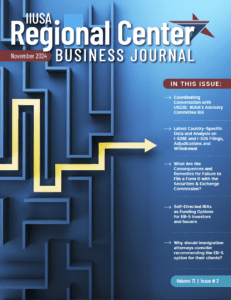By Jill Jones | General Counsel, JTC
EB-5 investors want security for their funds, and the best way to provide that is to avoid restricting your banking to a single institution and go with a flexible option.
EB-5 investors put a lot on the line when they embark on their EB-5 investing journeys. Not only is their invested capital at risk, but their immigration status depends on the successful use of that capital to create jobs for US taxpayers. A failure to timely invest the funds in job-creating activities could mean losing their chance to resettle in America, so they can’t afford to make a mistake.
More than financial returns, these investors care about security: they want to feel confident their funds will be managed properly, and their visa applications will be successful. Choosing the right banking partner can offer peace of mind that funds will be protected – because in 2023, we’ve seen what can happen when a bank fails.
Why EB-5 stakeholders are especially vulnerable to bank failures
This year has seen three of the four largest bank failures in the history of the United States. While these banks had different reasons for their financial troubles, they had many things in common: all were regional banks that dealt in specialty deposits – the exact category of banks often used for EB-5 subscriptions. In fact, Signature Bank, which was taken over by federal regulators in March, was a major player in EB-5 banking.
Why are regional banks used so often for EB-5 deposits when larger banks are more likely to survive a financial crisis? And what can be done to mitigate risk and assure investors that their funds are safe? Protecting investor funds requires understanding what is required of a bank to take EB-5 deposits, what can go wrong, and how to offer flexibility for investors.
Banks and EB-5: bigger isn’t always better
Investors concerned about potential bank failure may wonder why a Regional Center doesn’t choose to work with the largest and most established financial institutions available. The reason is that the largest banks have no appetite for EB-5 deposits.
Larger banks have established policies and infrastructure in place, and don’t want to alter their procedures for a market they might see as too small to be worth their while. And because EB-5 funds come from all over the world, the due diligence and AML/KYC procedures to verify source of funds can be difficult, especially from countries with remittance restrictions where investors may need to engage in currency transfer services or seek assistance from several friends and family members to export funds in multiple smaller tranches, not just one.
Unlike their larger counterparts, regional banks have a desire to source more deposits, making it worthwhile for them to invest the time and resources to understand EB-5 rules and design internal processes to comply with regulators. By specializing in sectors like EB-5, they can build a niche business where they won’t be competing with larger banks. That specialization should be seen as a good thing for investors, who benefit from a bank with EB-5 experience.
EB-5 is a complex and nuanced world, and regulatory compliance is of the utmost importance. Even if larger banks were an option, regional banks with specific EB-5 expertise could still provide investors with greater confidence that their funds will be released when necessary and won’t be disbursed in a way that violates EB-5 rules.
That said, regional banks often have more risk associated with them due to high LTD ratios and a tendency to become overleveraged in specific sectors. For normal depositors, this risk isn’t a big issue, as FDIC insurance can protect their deposits. But what about those depositing more than the $250,000 FDIC limit? Will they lose their funds?
CONTINUE READING









